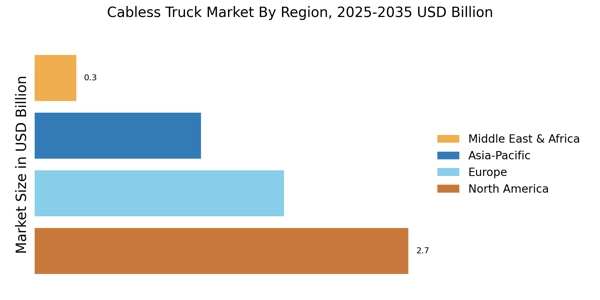Technological Innovations in Cabless Truck Market
The Cabless Truck Market is experiencing a surge in technological innovations, particularly in automation and connectivity. Advanced driver-assistance systems (ADAS) and autonomous driving technologies are becoming increasingly prevalent. These innovations not only enhance safety but also improve operational efficiency. According to recent data, the integration of these technologies could potentially reduce operational costs by up to 20%. Furthermore, the rise of Internet of Things (IoT) applications in logistics is transforming how cabless trucks are monitored and managed. This technological evolution is likely to attract significant investments, as companies seek to leverage these advancements to gain a competitive edge.
Sustainability Initiatives in Cabless Truck Market
Sustainability is becoming a central theme in the Cabless Truck Market, as companies strive to reduce their carbon footprints. The push for greener logistics solutions is prompting manufacturers to develop electric and hybrid cabless trucks. Recent statistics reveal that the market for electric trucks is expected to grow at a compound annual growth rate of 25% over the next five years. This shift towards sustainable transportation not only aligns with regulatory requirements but also meets consumer demand for environmentally friendly practices. As sustainability initiatives gain traction, the cabless truck market is likely to witness increased investment and innovation.
E-commerce Expansion and Its Impact on Cabless Truck Market
The rapid expansion of e-commerce is significantly influencing the Cabless Truck Market. As online shopping continues to grow, the demand for efficient and timely delivery solutions is paramount. Data indicates that e-commerce sales have seen a consistent increase, with projections suggesting a growth rate of over 15% annually. This trend necessitates the adoption of cabless trucks, which offer enhanced delivery capabilities and reduced operational costs. Companies are increasingly investing in cabless truck fleets to meet consumer expectations for faster delivery times. Consequently, the e-commerce boom is likely to drive substantial growth in the cabless truck sector.
Regulatory Changes and Their Influence on Cabless Truck Market
Regulatory changes are playing a pivotal role in shaping the Cabless Truck Market. Governments worldwide are implementing stricter emissions standards and safety regulations, which are influencing the design and operation of cabless trucks. Compliance with these regulations is becoming increasingly important for manufacturers and operators. Recent data indicates that regions with stringent regulations are seeing a faster adoption of electric and autonomous cabless trucks. This regulatory landscape is likely to create both challenges and opportunities for the industry, as companies must innovate to meet new standards while also capitalizing on the demand for compliant vehicles.
Urbanization and Infrastructure Development in Cabless Truck Market
Urbanization is reshaping the logistics landscape, thereby impacting the Cabless Truck Market. As cities expand, the need for efficient transportation solutions becomes more critical. The increasing congestion in urban areas necessitates the use of cabless trucks, which can navigate through tight spaces and reduce delivery times. Infrastructure development, including smart city initiatives, is further facilitating the adoption of cabless trucks. Data suggests that urban logistics could account for over 30% of total logistics costs by 2030, emphasizing the need for innovative solutions. This urban shift is likely to drive demand for cabless trucks, as companies adapt to changing urban environments.


















Leave a Comment